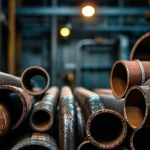Protecting delicate bottles demands more than standard packaging. Sustainable cardboard separators offer a smart, eco-friendly solution that not only ensures safety during transport but also reduces environmental impact. Choosing the right separator type and mastering the packing process can enhance bottle stability while supporting greener practices. Discover how this simple switch benefits your products and the planet alike.
Eco-Friendly Protection for Fragile Bottles
Small text
Also read : What Opportunities Exist for Growth in UK Business Services?
Sustainable cardboard separators offer a highly effective way to secure delicate bottles during both transport and storage. These separators create individual compartments that prevent bottles from colliding, significantly reducing the risk of breakage. By cushioning bottles and keeping them firmly in place, they maintain the integrity of the contents without relying on plastic or foam materials.
Choosing eco-friendly bottle protection goes beyond safety—it reflects a commitment to the environment. Sustainable materials like cardboard are biodegradable and recyclable, minimizing waste in landfills. This aligns with growing consumer demand for greener packaging, making it an appealing choice for businesses aiming to reduce their carbon footprint.
Also read : What Opportunities Exist for Growth in UK Business Services?
The benefits of sustainable packaging with cardboard dividers include:
- Increased durability compared to flimsy separators
- Lightweight design that lowers shipping costs and emissions
- Compatibility with automated packing systems for efficiency
Opting for sustainable cardboard separators ensures bottles arrive intact while supporting circular material use. For businesses and individuals who prioritize secure delicate bottles alongside responsible environmental practices, eco-friendly bottle protection provides a practical and conscientious solution. To explore more about cardboard dividers and their protective qualities, you can find detailed information on sustainable options like these.
Types of Sustainable Cardboard Separators
When considering cardboard separator types for bottle packaging options, understanding the materials and designs available is crucial. Commonly, three main types of cardboard separators are used: corrugated, molded, and honeycomb structures. Each offers different characteristics suited for specific packaging needs.
Corrugated cardboard separators are made from fluted paper sandwiched between flat liners, providing excellent cushioning and durability. These are typically single-use but can incorporate a high percentage of recycled materials, making them an eco-friendly choice for one-time shipments.
Molded cardboard separators offer a custom-fit design molded around bottles to prevent movement and damage. They often use recycled fibers but tend to be more resource-intensive in production compared to corrugated options. Molded separators are generally single-use, but advances in design are enabling some reusable variants.
Honeycomb cardboard separators form a hexagonal cell pattern, delivering strong structural integrity with minimal material use. They can support heavier loads and be designed for reuse, which is advantageous for sustainable packaging cycles. The honeycomb structure often comprises recycled materials, boosting its eco credentials.
The key distinction between single-use and reusable separators lies in durability and cost-effectiveness. Single-use separators, like many corrugated and molded variants, provide immediate protection but generate waste after one shipment. Reusable separators, commonly using honeycomb designs, offer long-term savings and reduce environmental impact, though they require initial higher investment and robust logistics for return and reuse.
In terms of material content, cardboard separators vary between recycled and virgin fibers. Recycled materials reduce reliance on new resources and often perform comparably to virgin fibers. Choosing separators with higher recycled content aligns with sustainability goals and reduces packaging’s carbon footprint.
Exploring eco-conscious bottle packaging options benefits from carefully selecting from these cardboard separator types, balancing protection, sustainability, and cost. For fragile goods, incorporating additional packaging measures like cardboard dividers can further enhance safety while minimizing environmental impact.
Step-by-Step Guide to Using Cardboard Separators
Careful preparation and arrangement are key when using cardboard separators to secure bottles sustainably.
First, begin by preparing the bottles and separators for packing. Ensure each bottle is clean and dry, and gather enough cardboard separators sized appropriately for the bottles. Cardboard separators work by creating individual compartments that prevent bottle-to-bottle contact, which minimizes breakage. Proper preparation also includes inspecting the separators for any damage or deformities that could undermine protection.
Next, follow these bottle packing instructions closely to arrange the bottles within the box. Place a cardboard separator at the bottom of the box as a sturdy base layer. Then, insert each bottle vertically into its designated compartment created by the cardboard dividers. It is crucial to position the bottles snugly so they do not shift. Between layers of bottles, add additional cardboard separators for cushioning and separation.
To ensure maximum stability and preventing movement during shipping, after all bottles are arranged with separators, fill any gaps around bottles with eco-friendly packing materials or small cardboard pieces. Finally, place a secure top layer of cardboard separators before sealing the box. This layered approach locks the bottles in place firmly, reducing vibration and impact risks during transit.
Using cardboard separators in this systematic way guarantees well-secured, sustainably packed bottles that reach their destination intact. This method not only protects fragile contents but also supports eco-conscious packaging efforts efficiently. For more details on environmentally friendly options, see resources on cardboard dividers.
Benefits Compared to Conventional Alternatives
Sustainable shipping solutions using cardboard dividers offer significant environmental benefits compared to traditional plastic or foam separators. Unlike plastic separators, cardboard is biodegradable and much easier to recycle, reducing landfill waste and pollution. This difference sharply lowers the overall environmental impact, making cardboard a preferred choice for companies aiming to minimize ecological harm.
From a cost perspective, cardboard often proves more economical than foam or plastic. It is lightweight, which means shipping costs decrease as less fuel is required during transportation. Additionally, cardboard’s recyclability closes the material loop, promoting a circular economy—something that plastic struggles with due to its complex recycling process.
When comparing cardboard vs plastic, the carbon footprint of cardboard is substantially smaller. Producing cardboard generally emits fewer greenhouse gases than manufacturing plastic alternatives. Furthermore, because cardboard breaks down naturally, it avoids the long-term pollution issues posed by plastics that persist in the environment for decades.
These benefits together illustrate why switching to cardboard separators represents not only a sustainable choice but also a practical one that aligns cost-efficiency with environmental responsibility. For businesses looking to reduce their carbon footprint, investing in cardboard dividers is a compelling sustainable shipping solution that balances performance with green credentials.
Choosing the Best Cardboard Separator for Your Needs
When selecting the best cardboard separator, understanding the specific requirements of your bottles is essential. Factors such as bottle size, shape, and quantity directly influence which type of separator will provide optimal protection during storage and transport. For example, larger bottles may need thicker separators with reinforced dividers, while smaller bottles can be safely arranged with lighter options.
Durability and strength are critical when assessing packaging materials. The separator must withstand pressure and impact to prevent bottle breakage. Look for separators made from sturdy, eco-friendly cardboard that offers resilience without adding unnecessary weight. Quality sustainable separators not only protect your products effectively but also align with environmentally conscious practices.
Sourcing quality sustainable separators involves verifying the supplier’s manufacturing standards and material origin. Reliable providers often offer customizable options, allowing you to tailor the divider structure to fit your bottles perfectly. Using standardized cardboard dividers helps maintain consistency and enhances protection, significantly reducing the risk of damage.
By focusing on bottle protection tips such as evaluating the shape and fragility of your bottles along with the separator’s strength, you can confidently choose packaging materials that safeguard your products while supporting sustainability goals.
Do-It-Yourself Solutions and Product Recommendations
Creating your own DIY bottle separators from cardboard is a practical, eco-friendly approach to safely packaging glass bottles. To make effective cardboard bottle separators at home, start by selecting sturdy, corrugated cardboard sheets. Cut out dividers tailored to fit the dimensions of your bottles, ensuring each slot snugly holds a bottle to prevent movement during transit. Folding and assembling the cardboard into grids or honeycomb layouts enhances structural integrity and shock absorption, offering excellent protection without extra padding.
For those who prefer ready-made options, several recommended cardboard separators are available from sustainable packaging brands known for quality and environmental responsibility. These products prioritize recycled materials and are designed to be both durable and biodegradable. Buyers often attest to the reliability of divisors that balance strength with ease of use, improving packaging efficiency while aligning with eco-conscious values.
The packaging industry is continuously advancing with innovative solutions. New sustainable packaging brands are introducing cardboard separators incorporating recycled fibers or utilizing modular designs that optimize space and reduce waste. These trends reflect growing demand for packaging that is not only protective but also minimizes ecological impact, making cardboard bottle separators a front-runner in green packaging technology.
For a practical guide on crafting your own separators, as well as exploring top sustainable brands, detailed instructions and product insights provide an excellent starting point. If protection and sustainability matter to you, exploring DIY options or choosing from market-tested cardboard separators is both feasible and impactful. Cardboard dividers, in particular, strike a beneficial balance between practicality and environmental stewardship.





